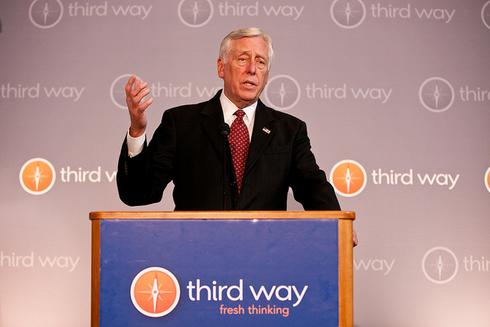BUSINESS
The NY Times Calls Third Way “Center-Left” and Turns a Study on its Head
March 25, 2013 · 1 Comments
Source: New Economic Perspectives

Above: House Minority Whip Rep.Steny Hoyer speech to Third Way on the deficit.
By William K. Black:
Some lies will not die. As I have demonstrated repeatedly, Third Way is Wall Street on the Potomac. It is funded secretly by Wall Street (it refuses to reveal its donors), it is openly run by Wall Street, and it lobbies endlessly for Wall Street. Third Way, like every Pete Peterson front group, is dedicated to shredding the safety net as its highest priority and throwing the Nation back into a gratuitous recession through self-destructive austerity.
Third Way, like other Pete Peterson front groups, supports privatizing Social Security. That is Wall Street’s greatest dream, for it would increase their revenues by hundreds of billions of dollars. Eric Laursen documented Wall Street’s effort to in his recent book: “The People’s Pension: The Struggle to Defend Social Security Since Reagan.” Laursen describes the Third Way’s leader as a Pete Peterson protégé. Peterson is a conservative Republican billionaire made wealthy on Wall Street, who has dedicated a billion dollars of his wealth to his assault on the safety net.
I showed in these pieces how journalists and Republicans used Third Way’s “false flag” status as a self-described “center-left” organization to add faux credibility to their arguments. The Republicans, for example, used comments by one of Third Way’s founders deriding Elizabeth Warren as the centerpiece of ads trying to defeat Elizabeth Warren in her run for the U.S. Senate. Similarly, the Washington Post’s ultra-deficit hawk, Robert J. Samuelson, used Third Way’s support of austerity as faux evidence that even liberals who studied the question realized the need to inflict austerity on the Nation.
One of my prior articles provides the finance background of every member of Third Way’s governing board – exposing the total dominance by Wall Street and finance. My goal was to make it impossible for a journalist who did, even the most perfunctory research, on Third Way to describe it as a “center-left” organization (or any analogous term).
I had not counted on the New York Times failing to clear such a tiny research hurdle. Sadly, on March 20, 2013 the New York Times gave prominent coverage to a study sponsored by Third Way, which the reporter called “a center-left policy research organization” in an article entitled “As Men Lose Economic Ground, Clues in the Family.”
Once again, Wall Street’s cynical effort to mislead by labeling its far-right economic policies and its lobbying group as “a center-left policy research organization” has triumphed. It triumphed because the curve of Wall Street’s cynicism intersected with the curve of lazy journalism at their respective maxima. The reporter emphasized Third Way’s faux “center-left” politics and its faux “research” function to make his story and the report seem more credible to the reader. The “central-left” aspect was supposed to lend credibility because the study was portrayed as supporting some extremely conservative memes. If even lefties admit that conservatives are right about the family and marriage, then surely the study is correct. It also suggests that Third Way must be a remarkable research organization because it is a “center-left” group, that sponsors research, that discredits “center-left” family policies.
None of this faux legitimacy is warranted. Third Way is a lobbyist for Wall Street. It conducts minimal research. Its publications overwhelmingly read like crude propaganda attacking the safety net, trying to create a “moral panic” about the deficit, and praising big finance. Third Way religiously avoids discussing the massive growth of inequality (driven largely by finance). (I used their web site’s search feature to find references to “inequality” without results.) Third Way’s introduction to the report explains that it is part of a series of pieces designed not to be objective research. Instead, Third Way admits that it is sponsoring pieces it intends to “confront” the Democratic Party in a “provocative” manner – pieces premised on the view that government fails because it embraces the Democratic Party’s obsolescent dogmas.
With no sense of irony, Wall Street (via its Third Way lobbyists), purports to instruct the Democratic Party on how to become the Party of the middle class. Third Way implies that the Democratic Party is the enemy of the middle class and that Wall Street is its great supporter. Third Way represents the maximization of Wall Street cynicism and duplicity. I will also show that the “provocative” study Third Way sought to “challenge” Democratic Party policies does not address the middle class or support Third Way’s disdain for Democratic Party policies. Indeed, a close examination shows that Third Way has it exactly wrong. The Democratic Party’s policies are far more supportive of middle-class families, are perceived by middle-class families as superior to that of the Republican Party, and the policies Wall Street seeks to inflict on the Nation through its Third Way lobbyists are profoundly hostile to the interests of middle-class, working-class, and poor families.
David H. Autor, the scholar, that Third Way sponsored to conduct this study, is very far from “center-left.” He self-describes his principal affiliations as “MIT-NBER.” NBER is an exceptionally conservative economics group. Yes, it has several famous “center-left” economists associated with it, but the NBER’s philanthropic funding has come heavily from ultra-far-right organizations.
“Between 1985 and 2001, the [NBER] received $9,963,301 in 73 grants from only four foundations:
- John M. Olin Foundation, Inc.
- Lynde and Harry Bradley Foundation
- Scaife Foundations (Sarah Mellon Scaife)
- Smith Richardson Foundation”
Each of these foundations is among the most extreme right-wing donor groups in existence.
Autor’s prior work is very far from “center-left.” His best-known causes include warning that Social Security disability payments need to be cut sharply. “The Unsustainable Rise of the Disability Rolls in the United States: Causes, Consequences, and Policy Options.”
Autor’s articles pushing for cuts to Social Security disability payments were music to the ears of Wall Street lobbyists, such as Third Way. Autor’s efforts to cut disability payments were all the more revealing when viewed in conjunction with his research findings about the impact of globalization on U.S. workers. “Trade Adjustment: Worker Level Evidence.”
Autor’s study on trade found that cuts in disability payments would have a particularly harsh effect on those most in need because disability was often the only source of income available to the U.S. workers harmed the worst by imports.
“We find that workers who in 1991 were employed in industries that experienced high subsequent levels of import growth garner lower cumulative earnings over the subsequent sixteen years (1992 through 2007) and are at substantially elevated risk of obtaining Social Security Disability Insurance benefits as the only recorded source of income in a given year.”
Autor wrote to criticize policies strongly supported by the center-left, that protect workers from unjust terminations in an article entitled: “The Cost of Wrongful-Discharge Laws.”
The paper was prepared for the Yale Law School’s “John M. Olin Center for Studies in Law, Economics, and Public Policy.” The Olin foundation grants, that created this and many similar centers, were created for the express purpose of making theoclassical economics and law and economics dominant. The foundation successfully sought out scholars to run these centers who despised U.S. governments and thought that regulation was a plague. Autor’s paper argued that employers reacted to certain forms of prohibitions on unjust terminations by cutting back hiring.
Autor is also known for his work arguing that the federal minimum wage has little effect in reducing inequality. Again, his position is the opposite of center-left scholars.
To sum it up, a far right group of Wall Street lobbyists hired a scholar well-known for his very conservative views on labor and the safety net and he produced a paper with very conservative views on the family. This happens on a daily notice and would normally be met with appropriate caution by people who did not have very conservative views. The scam that distinguishes this study is that it was deliberately rolled out by Third Way as a “center-left” study, that should be interpreted as exceptionally credible because it supported conservative views on the family.
The NYT fell for the scam hook, line, and sinker because its reporter did not bother to do even the most basic research on Third Way’s real nature. The reporter had plenty of clues – Third Way provided an introduction to Autor’s work that states that Third Way is commissioning papers for the express purpose of “challeng[ing]” Democratic Party policies in a “provocative” manner.
I want to be clear as to my comments about Autor’s policy views. I do not argue that his views or research should be disregarded because he is opposed to so many “center-left” policies. The point I am making is that Wall Street designed Third Way, and Third Way designed how it packaged and promoted the Autor piece, to mislead journalists, readers, and policy makers into believing that the study was entitled to a presumption of unusually great credibility because it was a “center-left”-sponsored study, that purportedly reported results hostile to “center left” policies. The reader will see that the thrust of this article is demonstrating that Autor’s findings refute the spin that Third Way put on his work and theNew York Times accepted as revealed truth.
Autor’s work is a (misfired) salvo in Third Way’s rolling barrage on behalf of Wall Street
Third Way says that it is commissioning a series of papers whose concern will be the “middle-class” — not the working-class or the poor. Third Way makes clear in its introduction to Autor’s paper that it starts with the presumption that the public sector is a failure because it is imprisoned by obsolete dogmas of the Democratic Party — just what one would expect to read from a “center-left” perspective. Either, the reporter never read the Third Way materials or he has an idiosyncratic definition of “center-left.” To judge by Third Way’s introduction to the Autor paper the definition of the “center-left” policy papers, that Third Way is commissioning, is that they will represent the policies of the portion of the political spectrum filled by Governor Mitt Romney.
Autor’s findings do not support Third Way’s theses or conservative family policies
Third Way’s introduction claims that there has been a “dramatic decline in the gender gap.” The reality is more complex and troubling — and it is one of the primary subjects, that my spouse, June Carbone, and her co-author Naomi Cahn study. It is a prominent subject in their next book — Family Classes: What is Really Happening to the American Family. The gender income gap has risen sharply among wealthy Americans, driven larger by finance.
Alexander Eichler, Gender Wage Gap Is Higher on Wall Street than Anywhere Else, Huffington Post, Mar. 19, 2012,
“The six jobs with the largest gender gap in pay and at least 10,000 men and 10,000 women were in the Wall Street-heavy financial sector: insurance agents, managers, clerks, securities sales agents, personal advisers and other specialists.”
Frank Bass, Shining Shoes Best Way Wall Street Women Outearn Men, Bloomberg (Mar. 16, 2012, 1:01 PM).
(Understandably, because Third Way is really Wall Street on the Potomac, it has no interest in telling this part of the story.) It is finance, that is the largest single driver in increasing overall inequality arising from greater returns to the wealthy. It is also finance, through globalization, that aids and abets the portion of the rise in inequality driven by reduced wages and employment for working- and middle-class Americans. I noted earlier that Autor’s earlier study found that international trade caused serious losses to many U.S. workers.
Third Way’s introduction to the study, and the Autor study, ignore finance and the resultant surge in gender inequality in that field. Here is the conservative meme that the NYT article emphasized.
“Men who are less successful are less attractive as partners, so women are choosing to raise children by themselves, producing sons who are less successful and attractive as partners.
‘A vicious cycle may ensue,’ wrote Professor Autor and his co-author, Melanie Wasserman, a graduate student, ‘with the poor economic prospects of less educated males creating differentially large disadvantages for their sons, thus potentially reinforcing the development of the gender gap in the next generation.’”
This description is wrong in important ways and it is misleading in its generality because the intersection of race and class drive many of the key relationships. Women with college degrees who have children overwhelmingly get married. Their rate of births outside of wedlock has fallen for decades and is lower today than it was over 40 years ago.
Autor agrees with Cahn and Carbone that what is going on among the groups he considers successful — college graduates — is greatly increased “assortative mating.” The figure he uses is that roughly 70% of college-educated males marry college-educated females. The comparable percentage for female college graduates is high, but materially lower. So, it is not accurate that women choose to raise children without male partners when the males available to them are “less successful.” Successful women often marry “less successful” males. Successful men are less willing to marry “less successful” women.
The men that women refuse to marry when they have children are not “less successful” — the mothers believe they are not fit partners to marry or to raise children because they would be (net) burdens or even pose threats to them and their children. Understanding that, somewhat subtle, distinction between “less successful” and unfit is essential to understanding family formation. Third Way seems to believe that Autor’s argument is that if we could induce poor black mothers to marry the birth father their male children would have far superior outcomes. But the superior outcomes come from studying what happens when mothers marry or partner with males they consider fit for marriage and childrearing. To state what should be obvious, but is typically ignored, such studies cannot be used to predict similar superior outcomes were for children mothers to marry or partner with unfit males. Autor concedes that many adult males are not “marriageable quality.” Many women who have children out of wedlock are teenagers impregnated by teenagers. Marrying the father would often ensure recurrent family financial crises. Autor concedes that the viciously high incarceration of young black males, largely on drug offenses, is one of the principal factors reducing the pool of marriageable males for black women.
The NYT article concludes by pitching Third Way’s views.
“Conservatives have long argued that society should encourage stable parental relationships. Liberals have tended to argue that the government should focus instead on improving economic opportunities. Jonathan Cowan, the president of Third Way, said the paper underscored that addressing social problems was a means to improve economic opportunities.
‘If Democrats have as their goal being the party of the middle class, they have to come to the realization that they’re not going to be able to get there solely through their standard explanations,’ said Mr. Cowan, a veteran of the Clinton administration. ‘We need to ask, ‘How can we get these fathers back involved in their children’s lives?’”
Third Way, as is its norms, claims that Democrats do not understand why “middle class” families are in trouble. The NYT author implies that the study proves that conservatives get it right about the family and that the central problem is among middle class families. But Third Way and the NYT author have it exactly wrong, and Autor’s study refutes their assertions. These family characteristics and public policy issues were the subject of Cahn and Carbone’s first book: Red Families v. Blue Families.
Autor agrees with Cahn and Carbone that the changes he is concerned about are heavily driven by class and that the patterns he decries are overwhelmingly driven by the intersection of low social class and race. He quotes a lengthy passage emphasizing this point from Andrew Cherlin and then concludes that the problem is the intersection of low social class and race (pp. 37-38). Autor’s data show the opposite of how Third Way and the NYT misconstrued his findings. Third Way ascribes the problem to (1) the middle-class and (2) outmoded Democratic Party policies focused on addressing the needs of families presented by the intersection of race and low social class. Autor shows that the Democratic Party’s analysis of the nature of the problem is correct — and Third Way is wrong.
Autor’s data show that the states and the people, that most closely follow policies embraced by the Democratic Party, have highly effective results for the middle-class, that the middle-class strongly supports these policies, and that the middle-class families express general satisfaction with their marriages and families. Elites are even more consistently likely to follow the Democratic Party’s family policies than are the middle-class. The elites report increasingly successful and rewarding marriages and rapidly declining divorce rates. (Indeed, the overall drop in divorce rates is almost wholly attributable to the drop among college graduates.) Even Republican Party elites tend to follow the Democratic Party’s marriage-friendly policies. They teach their children to defer marriage and children until they have the financial ability and maturity to care for them. They teach their children to value education and seek advanced degrees wherever appropriate.
Carbone and Cahn summarized the experience of college educated women in an article entitled “The End Of Men Or The Rebirth Of Class?”
“This group has held the line on non-marital births, seen its divorce rates fall, and seen the likelihood that a fourteen-year-old will be living with both biological parents increase. Moreover, the group as a whole reports high rates of marital happiness and satisfaction.”
What is not working nearly as well is lower-class families, particularly lower-class, black families. The rates of birth out of wedlock are exceptionally high, marriage rates are exceptionally low, and divorce rates are high. Black teenagers are the group most likely to be allowed access solely to “abstinence only” (non) sex education and they often use contraceptives ineffectively.
Autor’s Work demonstrates that Democrats are the Party of Middle-Class Families
Cahn and Carbone’s first book documented the often stark differences between family formation in red and blue states. It turned out that with the exception of Utah, blue states typically outperformed red states in having lower divorce rates.
The Democratic Party’s economic policies are one of the most important contributors, under Autor’s logic, to the success of middle-class families. They have (generally) supported stimulus in response to the Great Recession. Republicans have sought to inflict austerity instead — the policy, that threw the Eurozone back into a gratuitous recession and cost millions of workers their jobs. I show specific examples below of Autor arguing that the key to strengthening the family is to support greater economic training. The Democratic Party was the primary supporter of job training programs and revenue sharing programs to avoid the draconian employment cuts by state and local governments (which disproportionately harm middle-class blacks and Latinos).
The Democratic Party has been far more supportive of providing young, sexually-active women with free contraceptives and education on how and why to use contraceptives effectively. This has helped substantially reduce unwed teenage births.
Democrats have frequently acted very badly by failing to make it a priority to end the crack v. powder cocaine sentencing disparities and the barbaric mandatory minimum sentences for drugs, but Republicans have been far worse. One of the best pro-family policies America could adopt would be to end anti-drug prohibition. Democrats are more likely to support that policy than are Republicans.
Democrats are more likely to support family and paternity leave policies for mothers and fathers. Autor’s article concludes that many parents feel overwhelmed.
Autor’s Work demonstrates that Third Way’s Policies Harm the Middle-Class
Autor makes the obvious, but vitally important, points that the U.S. has the most shameful record for children living in poverty of any highly developed nation and that this is harmful to the family in general and poor children in particular (pp. 38-40). Third Way is a leading proponent of the austerity policies, that have denied the funding to remove tens of millions of children from poverty.
We can now evaluate the validity of the points, that Third Way was quoted making in the NYT article (without any critical analysis by the reporter).
“Conservatives have long argued that society should encourage stable parental relationships. Liberals have tended to argue that the government should focus instead on improving economic opportunities. Jonathan Cowan, the president of Third Way, said the paper underscored that addressing social problems was a means to improve economic opportunities.
‘If Democrats have as their goal being the party of the middle class, they have to come to the realization that they’re not going to be able to get there solely through their standard explanations,’ said Mr. Cowan, a veteran of the Clinton administration. ‘We need to ask, ‘How can we get these fathers back involved in their children’s lives?’”
Autor’s research demonstrates that the best way to “encourage stable parental relationships” is to “focus … on improving economic opportunities.” Indeed, Autor cites the example of how job and skill training through a school “Career Academies” program led to increased education, increased employment, and “more stable parental relationships” (p. 31). Cowan, the Pete Peterson protégé, simply implies falsely that Autor’s specific suggestion for “addressing social problems” did not “focus … on improving economic opportunities.” Career Academies are precisely the kinds of programs Democratic Party policies have long supported. They are also the kind of programs, that would be cut or eliminated if Third Way succeeded in inflicting austerity on the Nation.
Autor’s study identifies another successful program for strengthening families — the Earned Income Tax Credit (EITC) — a program strongly supported by the Democratic Party and savagely attacked by many Republicans. Citizens to Enact Simpson-Bowles, for example, propose to eliminate entirely the EITC — pushing millions of Americans into poverty and, based on the studies Autor finds reliable, greatly harming families and, in particular, their male children (p. 43).
Note that Cowan then plants a red-herring — talking about the middle-class. The white middle-class overwhelmingly has fathers “involved in their children’s lives” — and Democratic Party policies strongly encourage that and have helped bring down substantially divorce rates. It turns out that Autor’s study confirmed that the Democrat’s “standard explanations” — the intersection of race and low social class, was correct, that the Democratic Party’s pro-family policies are correct, and that Third Way’s policies are disastrous for the groups in which it is the norm that fathers are only episodically and inconsistently “involved in their children’s lives.”
Autor’s conclusion is that changes in the labor markets that have driven the changes in the family (p. 50). Again, Autor reinforces the appropriateness of the Democratic Party’s “focus” that Third Way tries to dismiss as hopelessly antiquated — “improving economic opportunity.”
Third Way’s slogan is “fresh thinking,” but it was unable to formulate a single specific fresh policy purportedly based on Autor’s findings. The two interventions that Autor concludes were successful in aiding the family exemplify the Democratic Party’s theory of how to strengthen the economy, reduce inequality, and strengthen families. But you would think the opposite if you relied on the NYT article or Third Way’s introduction to his article.
By admin
Readers Comments (1)
Sorry, comments are closed on this post.










The NYT is living in la-la land. The US has been flying on one wing (and it ain’t the left one) for so long that they think it’s become the entire political spectrum.